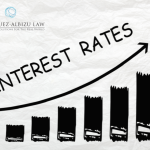The author of this article, Michael Ciardi, is a long time friend of the firm. Understanding interest rates and bank lending seems simple, it’s not. In this article Michael does a great job explaining how the money flows from the fed to the open market. I hope you enjoy the article, I know I did. – GR
By Michael Ciardi, Broker/Mortgage Loan Originator.
Today, it’s hard for anyone to avoid the glaring media and internet headlines touting “Federal Reserve lowers interest rate to near zero” and “Mortgage Interest Rates at Historic Lows”. The hype surrounding these headlines have exposed the general public’s misconception regarding how mortgage interest rates are determined and more importantly how published rates actually translate into the mortgage interest rates that are available to perspective borrowers. This prevailing misconception is further demonstrated by the fact that Mortgage Loan Originators are inundated with calls from eager borrowers with the unrealistic expectations of getting mortgages at the same rate banks are charged by the Federal Reserve for their overnight borrowings.
The real problem with understanding how rates are determined is that there are many players involved and there are a lot of moving parts to the art and science of mortgage interest rate-making. To say that the process is esoteric would be an understatement. At the macro level there are the overall influencers and drivers of mortgage interest rates: the current and future economic environment; consumer and investor behavior; supply and demand of investment funds; and lastly, inflation. Among the players are: the Federal Reserve; government sponsored enterprises (GSEs) – Fanny-Mae and Freddy-Mac; other mortgage aggregators- investment banks; retail banks and mortgage lenders; consumers; and most importantly Wall Street – investors of bonds and Mortgage Backed Securities (MBS).
The Federal Reserve has a dual role as both an influencer of rates through its monetary policy as well as an active one manipulating the rate it charges banks for their borrowings and by issuing Treasury Bonds and purchasing Mortgage Backed Securities when balancing of the market is necessary. The Fed’s aim is to keep inflation in check while providing enough liquidity in the investment market to avoid stifling economic growth. To the Fed Funds Rate, Banks tack on the margin necessary to cope with loan losses, pay for its overhead and loan expenses and generate profits for future growth and to compensate shareholders. As with any other business, banks are subject to market forces of supply and demand and competition. Not only is there competition between banks and mortgage lenders regarding mortgage rates but also there is competition at an investment level between Mortgages Backed Securities and other financial instruments that generate a return through interest yield that can ultimately effect mortgage interest rates. These are namely, the 10-year Treasuries and the 30-year long bond. Although these other investments compete for investment dollars, it’s the price paid by investors for Mortgage Backed Securities that figures heavily in the determination of mortgage interest rates and is mostly responsible for rate fluctuations. MBS rates may be stable for a long period of time or in periods of high market volatility vary as frequently as several times, daily.
What are Mortgage Backed Securities and where do they come to play in the mortgage rate equation? In order for lenders to have enough money to make more loans, mortgages are sold to investors in the “Secondary Market” where lenders can immediately get back their initial outlay plus a profit. The quasigovernmental agencies Fannie-Mae and Freddy-Mac, establish underwriting guidelines for mortgages they purchase, package similar loans into pools, and issue bond-like investment instruments called Mortgage Backed Securities to the Secondary Market that they also guarantee. These bonds are issued with coupons (interest yields) in half of a percent (50 basis point) increments depending on the risk associated with a specific loan pool. Typically, investors of these low-risk, real estate backed and guaranteed bonds are pension and hedge funds. In order for lenders to price their loans they must calculate the mortgage rate that will throw off the cash flows to generate a hypothetical coupon yield that will trade at a “par value” giving them the breakeven return they need. Since this hypothetical coupon return may not be available because it falls within the 50-basis point spread between MBS issues, a hedging technique called a Swap is used, a discussion of which is beyond the scope of this post.
However, this Swap Rate is used as a benchmark return for MBS investing and mortgage rate-making.
So in very simple terms, mortgage rates are determined by the cost of borrowings, the lenders margin to maintain profitability and the price investors are willing to pay for Mortgage Backed Securities for each loan based on associated cash flows and risk.
Lenders having established a mortgage “Par Interest Rate” is only half of the story because the rate charged on mortgages vary for each Borrower depending on a number of variables. Most or all of these Loan Level Adjustments can affect the mortgage rate a Borrower may be able to obtain. They are: Loan Program (Conventional, FHA, VA, USDA, Jumbo, Reverse), Loan Term (number of payments); Rate Type (Fixed, Variable, Interest Only); Loan Amount; Loan amount to value of the property (LTV); borrower’s credit score; borrower’s credit history (bankruptcy, short sales, deed in lieu, forbearance or loan modification); property location (by state); property type (single family or 2-4 family, condo, manufactured home); property use (primary residence, 2nd home, investment property); type of income (wage earner or self-employed); and when refinancing, taking cash out versus no cash out.
Although, these Loan Level Adjustments are set by the lender, a Borrower armed with the knowledge of what how rates are established can make a number of intelligent decisions that can result in substantial savings over the term of a mortgage. Among these are: selecting the proper loan program; choice of property type; maintaining or improving their credit score; when purchasing having a down payment of 20% or more (LTV); and limiting cash-out when refinancing.
So what appears to be a simple question – really isn’t. That’s why those of us in the mortgage industry cringe when we’re asked, “what’s the rate?”
A little about Michael Ciardi:
Carefree Retirement Funding d/b/a Carefree Mortgage, with offices in Stuart, FL and Asheville, NC, is a trusted Mortgage Brokerage offering conventional, government, reverse and commercial loans from the nation’s leading lenders. Carefree’s outstanding team of Mortgage Professionals average in excess of 15 years’ experience providing the highest quality service to meet their client’s financing needs.
Michael A. Ciardi
Broker/Mortgage Loan Originator
Carefree Retirement Funding, LLC d/b/a Carefree Mortgage
(NMLS#1557087)
734 Colorado Avenue
Stuart, FL 34994
(772) 212-1450 x101
[email protected]
https://www.carefreemortgageloans.com/michael-ciardi/






